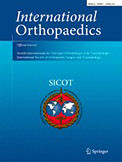Kos P, Varga F, Handl M, Kautzner J, Chudáček V, Držík M, Povýšil C, Trč T, Amler E, Hanus M. Int Orthop. 2011 Nov;35(11):1733–9. Epub 2011 Jan 18. IF: 1.561

Department of Orthopaedics
Abstract
OBJECTIVE: Improved staging of cartilage degeneration is required, particularly during the early stages. We correlated mechanical properties with histological and macroscopic findings. METHODS: One hundred and twenty cartilage samples were obtained during total knee arthroplasty. Two adjacent plugs were harvested – one for histological classification and one for macroscopic and biomechanical purposes. Dynamic impact testing was performed; normal stress, dissipated energy (ΔE), tangent modulus and stiffness were evaluated. RESULTS: Samples were classified according to six categories of the ICRS histological scale. Mechanical characteristics revealing significant differences between the groups (p < 0.01) were specific damping and related absolute ΔE. A significant correlation was found between the macroscopic score and specific damping, as well as absolute and relative ΔE (p < 0.01). A strong relation was revealed between relative ΔE and cartilage thickness (p < 0.001; R (2) = 0.69). CONCLUSIONS: Only ΔE correlated with the condition of the cartilage – the value increased with decreasing quality – and is the most suitable characteristic. This change appears substantial in initial stages of cartilage deterioration.
-mk-